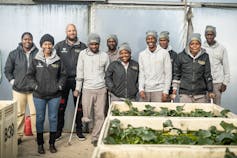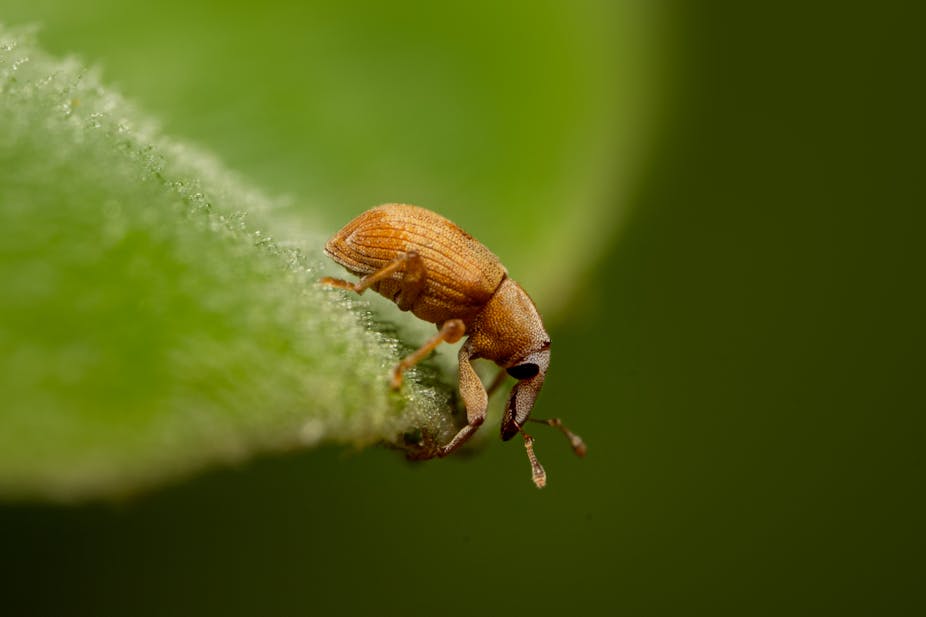Water lettuce (Pistia stratiotes L.), also known as Nile cabbage, is a free-floating aquatic plant from the family Araceae, the same family as the arum lily.
It’s found on every continent except Antarctica and grows well in tropical to sub-tropical climates. Research suggests it may have originated in South America because it has natural enemies there which have co-evolved with the plant. However, fossil records and ancient Egyptian hieroglyphics depicting water lettuce indicate that it may have been present in other regions for millions of years. It was likely spread around the world by early colonists as an ornamental plant for ponds and aquatic gardens.
Today, water lettuce is considered an invasive species in many parts of the world, including African countries, where it has caused significant negative impacts on aquatic ecosystems and human activities.
Recently, water lettuce has invaded one of South Africa’s most important rivers, the Vaal River, on the border of the Gauteng and Free State provinces. This has raised huge concerns for local communities, businesses and stakeholders, as well as Rand Water. Rand Water is the largest bulk water utility in Africa and is one of the largest in the world, providing bulk potable water to more than 11 million people.

I am the deputy director of the Centre for Biological Control at Rhodes University, where I manage the biological control programme on aquatic weeds in South Africa. My team and I are currently working with Rand Water on an integrated management plan for water lettuce control in the Vaal River. This comes after good results in controlling water lettuce in other parts of South Africa and in neighbouring countries such as Zimbabwe and Mozambique since 1985 – thanks to a small species of weevil.
The damage
Water lettuce forms dense mats on the water surface. This can reduce light penetration and oxygen levels in the water, negatively affecting all aspects of aquatic life from microscopic plankton to large fish. The mats can also impede water flow, leading to stagnation and increased mosquito breeding sites. Water lettuce can clog agricultural irrigation canals too. Its rapid growth can also interfere with fishing and boat navigation.
Management of water lettuce can include manual removal and the use of herbicides to prevent spread. Herbicides were routinely used to combat water lettuce in South Africa in the early 1980s, and are still relied on heavily in the US, particularly in Florida.
Read more: Invasive alien species are a serious threat to the planet: 4 key messages for Africa
However, these methods are labour-intensive and often insufficient to control the plant’s rapid growth. They can also damage other vegetation.
That’s where biological control comes in. This involves the introduction of natural enemies like insects or pathogens, which can help manage the plant’s population more sustainably and effectively. By importing and releasing a suitable biological control agent, such as the water lettuce weevil Neohydronomus affinis, the negative effects of water lettuce on the environment and local communities can be mitigated.
The weevil
This Brazilian weevil species was first introduced to Africa in 1985 via Australia, following successful control of water lettuce infestations there. The then Department of Agriculture gave permission to release it in South Africa and 500 weevils were released into a heavily invaded pan in the northern Kruger National Park.
Since then, it has been used to control water lettuce infestations in Botswana, Benin, Ghana, Senegal, Zimbabwe, Zambia, Republic of Congo, Côte d’Ivoire, Kenya, Nigeria, Togo, Mozambique and Morocco. Invasions at sites in these countries, no matter how extensive, were generally brought under control within a year.
Read more: New bugs, found in Kenya, can help to control major maize pests
The impact of N. affinis on water lettuce populations is significant: the combined feeding activities of adult and larval weevils cause substantial damage to the plants, reducing their growth and reproductive potential. Adult weevils chew small holes in the leaves, while larvae tunnel through the leaves, causing them to waterlog and sink.
The ability of N. affinis to produce multiple generations per year enables it to quickly build up populations and maintain pressure on water lettuce populations over time, making it an effective biological control agent for managing water lettuce in affected areas.
As a host-specific insect, N. affinis poses little risk to non-target species or the environment. Biological control of water lettuce in Africa is considered one of the most successful programmes in the fight against invasive species.
So, how are these powerful weevils being used in the Vaal River?
The Vaal River
Water lettuce was first identified on a tributary to the Vaal River in 2021, but local conditions (floods and cold winters) appeared to have limited the spread of this plant. However, at the end of 2023, a large infestation was noticed on the Vaal River and was reported to relevant authorities.
Since then, the infestation has covered up to 40km of the river in the Vaal Barrage area, around the town of Vanderbijlpark, and threatens to spread downstream of the 1,200km long Vaal River.
Rand Water is following an integrated strategy to control and reduce the invasion. Biological control, using the water lettuce weevil, is key to the long term management of the water lettuce invasion. The Centre for Biological Control at Rhodes University is working closely with Rand Water to ensure a constant and abundant supply of the weevils – to do so, the centre has established weevil rearing stations.

Thousands of weevils have already been released into the Vaal River since November 2023 from our mass rearing facility in Makhanda. Weevils are also being reared by businesses and residents who live near the river, as well as Rand Water. The weevils will be released frequently and en masse, at crucial times, particularly after winter when the plants will germinate from seeds. This is termed inundative biological control.
Water lettuce is one of the easier invasive aquatic plants to control, biologically – soon the infestation will be under control. What lurks alongside this invasion on the Vaal River, however, is the water hyacinth, which remains South Africa’s most problematic aquatic invasive plant. It is a super competitor, thriving in the country’s nutrient rich waters. Efforts are underway by the Centre for Biological Control to highlight this threat. The quality of water upstream from the Vaal needs to be urgently remediated, as this is the ultimate cause of both the water lettuce and water hyacinth invasions.

